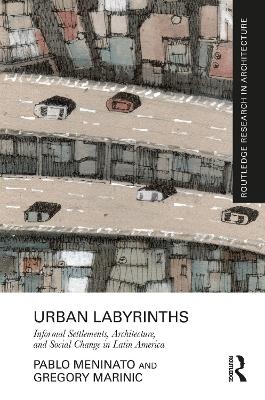
Urban Labyrinths
Routledge (Verlag)
978-1-032-50419-3 (ISBN)
Urban Labyrinths: Informal Settlements, Architecture, and Social Change in Latin America examines intervention initiatives in informal settlements in Latin American cities as social, spatial, architectural, and cultural processes.
From the mid-20th century to the present, Latin America and other regions in the Global South have experienced a remarkable demographic trend, with millions of people moving from rural areas to cities in search of work, healthcare, and education. Without other options, these migrants have created self-built settlements mostly located on the periphery of large metropolitan areas. While the initial reaction of governments was to eliminate these communities, since the 1990s, several Latin American cities began to advance new urban intervention approaches for improving quality of life. This book examines informal settlement interventions in five Latin American cities: Rio de Janeiro, Medellín, São Paulo, Buenos Aires, and Tijuana. It explores the Favela-Bairro Program in Rio de Janeiro during the 1990s which sought to improve living conditions and infrastructure in favelas. It investigates projects propelled by Social Urbanism in Medellín at the beginning of the 2000s, aimed at revitalizing marginalized areas by creating a public transportation network, constructing civic buildings, and creating public spaces. Furthermore, the book examines the long-term initiatives led by SEHAB in São Paulo, which simultaneously addresses favela upgrading works, water pollution remediation strategies, and environmental stewardship. It discusses current intervention initiatives being developed in informal settlements in Buenos Aires and Tijuana, exploring the urban design strategies that address complex challenges faced by these communities. Taken together, the Latin American architects, planners, landscape architects, researchers, and stakeholders involved in these projects confirm that urbanism, architecture, and landscape design can produce positive urban and social transformations for the most underprivileged.
This book will be of interest to students, researchers, and professionals in planning, urbanism, architecture, urban design, landscape architecture, urban geography, public policy, as well as other spatial design disciplines.
Pablo Meninato, PhD, is an architect, architectural critic, and educator. A native of Argentina, Meninato has practiced and taught architecture in Philadelphia, Buenos Aires, and Monterrey, Mexico. He is an Associate Professor at the Temple University Tyler School of Art and Architecture where he teaches history, theory, and urban design. Gregory Marinic, PhD, is an Associate Professor at the University of Cincinnati College of Design, Architecture, Art, and Planning SAID and Director of URBANIA, a grant-funded research lab. His current field research is based in Mexico City, Buenos Aires, Lima, La Paz, and Guayaquil where it focuses on housing, urban design, informal settlements, and urban morphology.
List of figuresForeword: Francesco M. OrsiniAcknowledgementsIntroduction Migratory Waves Right to the City? Nomenclature Addressing Informality Bibliographic Antecedents Structure of the Book Chapter 1. Rio De Janeiro Slavery. Brazil's Enduring Legacy Towards a New Epistemology of Favelas The Favela-Bairro Program Jorge Jáuregui. ‘Everything had to be built’ Favela Intervention Tactics. Urbanism, Architecture, and Landscape Design A Preemptive Balance of the Favela-Bairro Program Chapter 2. Medellín PRIMED: Laying the Foundations Sergio Fajardo's Citizen Commitment EDU and EPM: Redefining Governance Alejandro Echeverri and the Catalan Connection PUI: Towards an Urban Design Strategy for Informal Neighborhoods Case Study: PUI Nororiental Case Study: UVA de la Cordialidad Social Urbanism: Critiques and RecommendationsChapter 3. São PauloA Distinctive Urban History1980s, Brazil ‘Discovering’ FavelasThe Antonico Creek Project in Favela ParaisópolisUpgrading Favelas in ‘the Corner of Heaven’Devising Favela-intervention MechanismsChapter 4. Buenos Aires The Persistence of the Grid The Emergence of the ‘Villas Miseria’ and the Policies of Eradication Social Sciences, Journalism, and the Visual Arts Acknowledging the ‘Villas Miseria’ Urbanism Approximating Informality: Flavio Janches in Villa Tranquila Villa 31. A Bit of history On Housing, Civic Buildings, and Public Spaces Reasons for Optimism for a Fractured CountryChapter 5. Tijuana When Illicitly Dictates Urban Growth A Laboratory of Postmodernity On Paradises, Border Walls, and Canyons Los Laureles Canyon Oscar Romo, Alter Terra and the Poetics of Recycling Cruz & Forman: Manufacturing Informality Community Stations Integrating Formal and Informal Processes Informality in Tijuana as a Differentiated PathChapter 6. Theoretical Considerations Informal Cities Informality in Art Hélio Oiticica: Aspiring to a Large Labyrinth The Esthetics of the Favela: Paola B
| Erscheinungsdatum | 09.04.2024 |
|---|---|
| Reihe/Serie | Routledge Research in Architecture |
| Zusatzinfo | 8 Line drawings, black and white; 62 Halftones, black and white; 70 Illustrations, black and white |
| Verlagsort | London |
| Sprache | englisch |
| Maße | 156 x 234 mm |
| Gewicht | 453 g |
| Themenwelt | Naturwissenschaften ► Biologie ► Ökologie / Naturschutz |
| Naturwissenschaften ► Geowissenschaften ► Geografie / Kartografie | |
| Sozialwissenschaften ► Soziologie ► Spezielle Soziologien | |
| Technik ► Architektur | |
| ISBN-10 | 1-032-50419-6 / 1032504196 |
| ISBN-13 | 978-1-032-50419-3 / 9781032504193 |
| Zustand | Neuware |
| Informationen gemäß Produktsicherheitsverordnung (GPSR) | |
| Haben Sie eine Frage zum Produkt? |
aus dem Bereich


